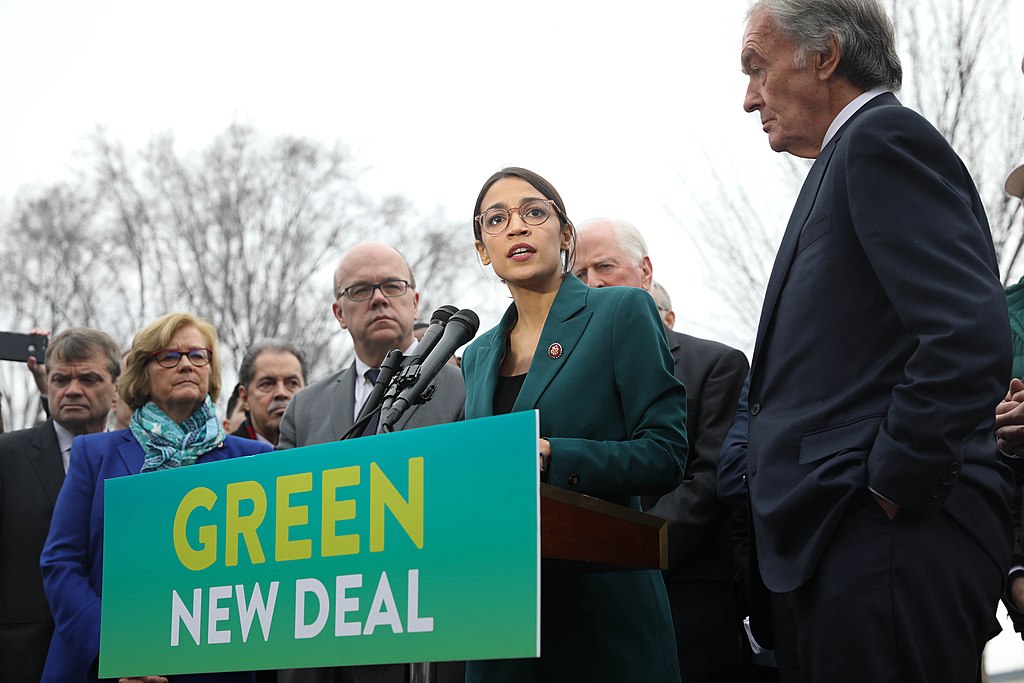Biden’s new climate plan, explained

15 July 2020
Presumptive US Democratic nominee Joe Biden announced another chapter of his climate plan yesterday. His plan, he proclaimed from a lone podium, contained the “most critical investments” the US could make in addressing the climate crisis and would be a cornerstone feature in his “Build Back Better” recovery plan.
His words were cast out to a country which is in the midst of ever-climbing coronavirus case numbers and continued economic decline. Some of its hardest hit states are also staring down the barrel of Hurricane season, and many pre-existing disaster plans haven’t factored in a pandemic.
So how did we get here? What (and who) helped shape his strategy? Will it have an impact in the voting booth come November 3rd? And what does it mean for the rest of the world?
We did some digging. But first, some background.
A breakdown of US emissions
The United States is by far the world’s largest historical emitter of greenhouse gases. It has produced roughly 25 per cent of the world’s emissions to date, while only having just over 4 per cent of the global population. It’s ecological footprint, simply put, is massive.
Nowadays it’s producing about 15 per cent of global emissions, which are coming from a number of different industries.
Transport is the US’s largest emitter accounting for 28 per cent of total emissions, followed closely by electricity at 27 per cent, industry at 22 per cent, and commercial and residential emissions clock in at 12 per cent and agriculture is responsible for 10 per cent of the country’s climate impact.
The two major political parties in the US have had long-standing and opposing views to emissions and their consequences. Republicans have typically been typecasted as climate deniers or indifferent to the issue, (although this appears to be changing) and Democrats, as they often label themselves, are people who “listen to the science” and want to act on climate change.
However, neither party has yet to see a president pursue climate action at the scale many scientists and activists have long called for.
The Obama administration, which had Biden serving as vice president, confined the majority of their climate accomplishments to the end of their time in the White House as the economy and health care were in the policy driver’s seat from day one.
While he did include an unprecedented $90 billion for clean energy in the post-recession stimulus package, Obama pushed through environmental legislation largely by executive action, meaning he was able to do so without needing to go to the House of Representatives and the Senate for approval.
This includes his Clean Power Plan, his rejection of the Keystone pipeline, a 2014 bilateral climate deal with China, signing the US up to the 2015 Paris Agreement, and banning arctic drilling.
However, by his term’s end and on the eve of a presidency that commonly refers to climate change as a “hoax”, the US remained the largest global producer of petroleum and gas hydrocarbons.
Post-Obama climate politics
Following the publication of the monumental Intergovernmental Panel on Climate Change (IPCC) report to keep global warming to 1.5 degrees in 2018, many US politicians to the left of the aisle started campaigning on and proposing concrete climate action.
The most well-known example of this was the Green New Deal, proposed by Congresswoman Alexandria Ocasio-Cortez and Senator Ed Markey following numerous community-led actions, many of which were organized by the Sunrise Movement.
The term has been in use since 2007, according to Vox energy correspondent David Roberts, and it refers to the New Deal, a series of programmes introduced by President Franklin D. Roosevelt in the 1930s to pull the country out of the Great Depression.
The actual document itself names key goals for the deal, including net-zero greenhouse gas emissions through job creation and a just transition. In order to get there, the country would have to take on a number of “projects”, including 100 per cent renewable electricity generation and energy-efficient buildings.
While the initial resolution failed, it became a buzzword on the Democratic primary trail, with 20 candidates either endorsing or co-sponsoring a Green New Deal as part of their platform.
Biden has called it a “crucial framework” for meeting the climate challenge at hand, but did not come out as forcefully for it as other candidates such as Senator Bernie Sanders and Senator Elizabeth Warren, who are further left on the US political spectrum.
Once Bernie Sanders ended his presidential campaign in April, Joe Biden all but clinched the nomination. But, given Sanders’ long standing popularity and wanting to avoid a fractured Democratic party, Biden quickly organized task forces staffed with representatives from both camps on a range of issues, including climate.
Green New Deal co-sponsor Alexandria Ocasio-Cortez co-chaired the task force with former US Secretary of State John Kerry, andthe team presented their recommendations to the Biden campaign last week. The decision to implement them was now up to Biden.

So, what happened?
Biden seems to have seriously reflected on what the taskforce had to say. To start, from a linguistic front, the new plan uses the term “climate crisis” repeatedly, something the earlier iteration failed to do.
He pledged to put the US on course for 100 per cent clean energy by 2035 and to ensure that disadvantaged communities are allocated 40 per cent of spending benefits from his climate plan.
In terms of public investment, it is a considerable shift from his initial plan. His campaign has now pledged to spend $2 trillion on climate in the first four years of its administration. Previously, Biden promised to spread out $1.7 trillion over the course of a decade to address the issue.
$300 billion of this fund would go towards Research and Development, with an emphasis on investment in “breakthrough technology”.
The policy itself continuously refers back to job creation as the US looks to exit a twinned public health and economic crisis and take on the climate crisis. It also repeatedly refers to workers’ right to unionize throughout.
These new and unionized jobs would be tasked with “rebuilding America’s crumbling infrastructure” and working towards decarbonizing the nation’s auto-fleet. In terms of public transport, a Biden administration would work towards zero-emission public transport options for every US city with a population of over 100,000 by the end of the decade.
He went on to promise the retrofitting of 2 million homes over his administration and the construction of 1.5 million new sustainable housing units. He hopes to cap abandoned oil and gas wells that continue to leak warming gases into the atmosphere and create 250,000 jobs in the process.
A Biden presidency would also seek to create “climate-smart” agriculture jobs and establish a Civilian Climate Corps, an idea proposed by Washington governor Jay Inslee, which would restore ecosystems around the country.
Environmental justice would have an overarching presence all of these decisions, Biden promises, and would guide his administration in “where, how and with whom we build”.
In addition to allocating 40 per cent of spending benefits to disadvantaged communities in areas like clean energy and the reduction of legacy pollution, the campaign also pledges to establish a new Environmental and Climate Justice Division within the Justice Department to “hold polluters accountable”, another suggestion via Governor Inslee.
The former proposal attempts to address the legacy of environmental racism in the US, as communities of colour have been and continue to be on the frontlines of pollution and damaging environmental practices.
So we have his plan, now what?
Some previous climate critics of Biden have reacted somewhat positively to the new plan, including the Sunrise Movement.
Its Executive Director Varshini Prakash sat on the Biden-Sanders taskforce and helped craft the recommendations put forward.
The plan itself, Sunrise said, “isn’t perfect and there are still gaps and places to push, but it’s a major step forward and parts are more ambitious than what Bernie Sanders ran on in 2016 or Jay Inslee championed in 2020.”
“We’ll have our work cut out for us in making this action a day 1 priority,” they added.
Some important questions remain to be answered around the new policy, Green New Deal policy architect Rhiana Gunn-Wright observed.
Taking to Twitter after the announcement, Ms. Gunn-Wright said she liked many aspects of the plan but said she felt like, “we’re still sidestepping important questions of power and its allocation”.
Among the questions she raises is community control over decisions that will ultimately affect them, and whether or not poor communities, especially with a people of colour majority population, will be offered, “the same level of control and over decisions and access regulatory processes that well-off, white communities have?”
New Republic’s Kate Arnoff stressed that a timeline was still not in place for, “getting the country off fossil fuels, leaving US producers largely free to dig up and export as many of those as they please, wherever they please”.
In an earlier discussion of the taskforce’s recommendations, she also rightly pointed out a key problem the Democrats would face in passing any sort of meaningful climate legislation: the Senate.
The Senate remains in Republican hands, and would be able to block any Democratic legislation put forward and shoot many of Biden’s proposals dead in the water.
If Biden wins the presidency in November, the Democrats would need to pick up three Senate seats to turn the tides of partisan control and ensure legislative smooth sailing.
Interested in how they could do that? The Washington Post has a great feature on it.
Finally, in terms of how the public has received the measures outlined in his latest climate announcement, it seems to bode well for Biden.
A poll conducted by Data for Progress took the temperature on the measures in the plan, with numerical majorities supporting key tenets of the proposals both nationwide and among independents in key battleground states.
The policy commitments, according to the think tank, mark “the arrival of a new climate politics at the core of the Democratic Party.”
Okay, so IF Biden wins and IF Democrats take back the Senate, what would a Biden climate presidency mean on a global stage?
Biden, like the vast majority of his primary competitors, pledges to re-enter the United States into the Paris Agreement on “day one” of his administration.
But if we go back to his initial climate policy document, he seems to be committed to pushing the US to be a global leader on the climate crisis.
Rejoining Paris is, “simply not enough” according to his campaign and the administration would aim to “use every tool of American foreign policy to push the rest of the world to raise their ambitions”.
Such tools would be convening a global climate summit and ensuring bilateral US-China agreements were made on the basis of carbon mitigation.
Another policy measure would be demanding a worldwide ban on fossil fuel subsidies. Any sort of government financial assistance to the industry, according to Biden, has “simply no excuse”.
If Biden wins in November and if he is serious and follows through with this, it could have massive global consequences if he is successful. Which is a lot of if’s.
Fossil fuel subsidies support the industry the world over, including right here in Ireland. Would Ireland follow Biden’s lead? Hard to know, given the amount of if’s at play. But it would be something for the Irish government to consider at least. (Want to find out more about Irish fossil fuel subisides? Check out Daniel Murray’s conversation with climate scientist John Sweeney.)
Again, there are a lot of if’s and questions still in the air regarding Biden’s climate policy, his chances of winning and his ability to govern. But it’s certainly one to watch and we’ll continue to keep our eye on it.
[x_author title=”About the Author”]







